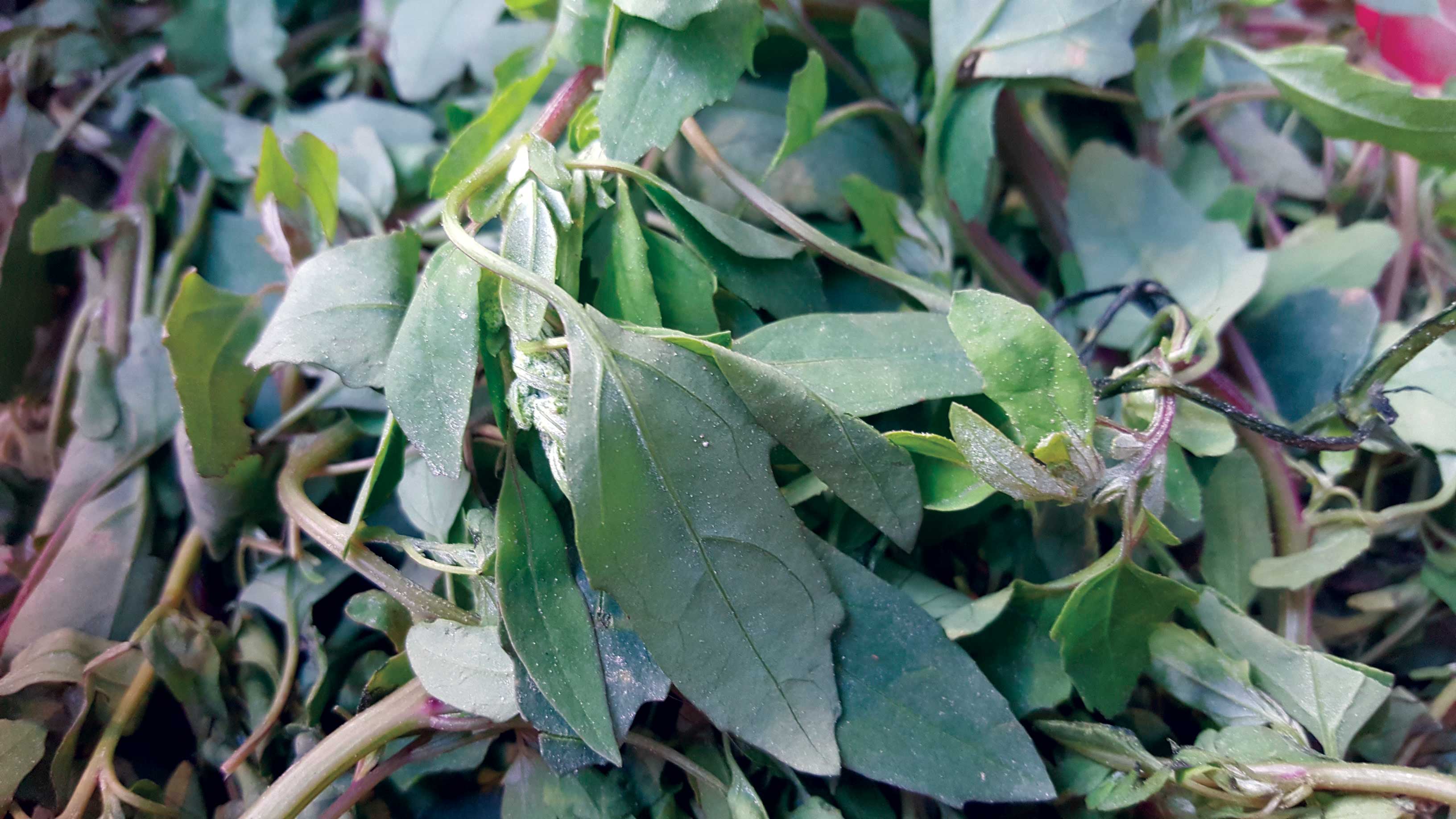It is undergoing restoration at the moment. When it once again opens to the public, one can rest assured that it will make quite a splash! It is one of the fabled architectural treasures of the ‘City of the Arts’.
Most people refer to it as the ‘Royal Bath’ but I don’t believe it,” says Dr Rohit Ranjitkar. He is talking about the Tusha Hiti in Sundari Chowk of Patan Durbar. Well, seeing that he is after all the Nepal Program Director of Kathmandu Valley Preservation Trust (KVPT) and that his organization has been awarded a substantial sum by the American Ambassador’s Fund to renovate and restore the hiti (sunken bath) to its rightful glory, one has to listen and listen well. But why does he think so? “The hiti is surrounded on all sides by figures of numerous deities and since the then King Siddhi Narasimha Malla (1619 - 66) was a most pious individual, I do not believe that he would stand naked before them,” says Ranjitkar.
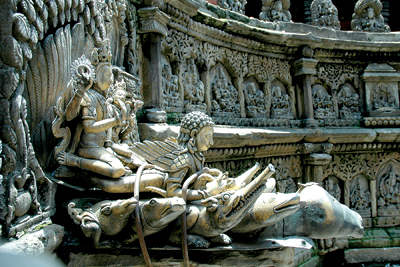
This beautiful figure is missing now - stolen!
Indeed, he has a valid point. Built in 1647, there are 52 stone figures (exquisitely carved ones at that) on three rows of small alcoves and on the edges all around this hiti. Not only that, there were two metal figures as well, but sad to say, both are missing from their places - stolen. In fact, one of them was the central figure just above the intricately detailed gilded copper repousse spout, and this was stolen just a year and a half ago when the restoration work had already begun, “It was one of the worst moments of my life,” says Ranjitkar. Nevertheless, even without the two missing figures, Tusha Hiti is a marvel to behold while at the same time one cannot but be surprised at the extravagance of the decorations in what is actually, a quite small sized bath. Built in an oval form, it is about 6ft x 8ft and is 5ft high. A miniature replica of the famous Krishna Mandir stands on its main axis.
This bath, Tusha Hiti, is located at the center of the square known as Sundari Chowk. The Patan Durbar has three other similar but varying in size, squares. Sundari Chowk (Beautiful Square) is expectedly, the one in which much effort has been made to live upto its name. One is forced to surmise that the artisans who worked at this site must have a hard time knowing when to stop, And so, one will notice that even the smallest decorative windows have such a wealth of detail including the finely carved toranas (wooden or metal carvings commonly found atop larger doorways and windows in temples) that much larger wooden carved windows in more ordinary places pale in comparison.

A Veritable plethora of deities from the Hindu pantheon surround the ‘royal bath’.
This square is really something else! No wonder the centerpiece, that is, the bath, had to be constructed in such a way as to make it befitting of the place. Two ananconda like stone serpents guard it on both sides while a small flight of stone steps go down a few feet into the pool. At the top, and to the front, are two tall pillars that face a massive rectangular shaped stone platform on which the king is said to have meditated daily. While most of the surrounding structures are made of wood, the bath and its immediate vicinity are all in stone. Not much sunlight enters the square, blocked as it is by the huge overhanging eaves of the pagoda roof. At the most, late afternoon sunlight covers half the square in the later part of the day, but since this is weak, the feeling one gets is that this square couldn’t have been particularly comfortable on winter days. No doubt, in the summer, it would have been a cool and welcome retreat to relax in and to conduct court activities. Now, since Ranjitkar is of the opinion that bathing in the Tusha Hiti was improbable, what with all the gods as witnesses, one does wonder if the bath was after all, just a fancy of the then king to add glamour to the square.
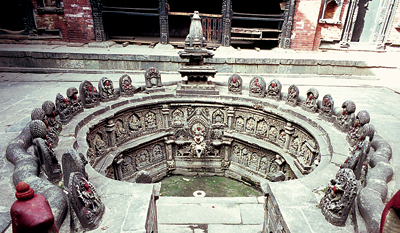
The bath with the central icon intact
Whatever the case may be, the Tusha Hiti and the Sundari Chowk are prime examples of Newari art and architectural skills. Taking its value into consideration, as also the fact that it stood in a state of sad repair for many years, the square has been closed to the public since 1993 to prevent vandalism, and is now well on its way to being restored to its original glory. The restoration, as restorations always are, is a slow and painstaking process, with even the tiniest detail coming under scrutiny before proceeding to the next step. Ranjitkar and KVPT received the abovementioned award in 2009 and they believe that the hiti and the square should be ready for public viewing within the next two years.
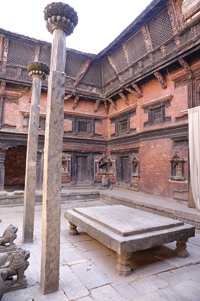
The massive stone platform in front of Tusha Hiti
These are actually, only a part (although a substantial part) of the larger restoration works of this part of the durbar and includes the Bhandarkhal Tank in the gardens behind as well. At the moment, skilled laborers are busy replacing rafters on the floors above while woodcarvers are busy making exact replicas of wooden pieces that have been lost or are beyond repair. A dozen or so massive struts lie in storage, waiting to be put into their rightful places. The large Bhandarkhal Tank with its raised pavilion is almost ready although the water is yet to be cleansed, deep green as it is now. KVPT’s works are funded by a couple of international organizations including a significant fund from a German institution. The American Ambassador’s Award was won through competition and is primarily meant for restoration works to do with Tusha Hiti and Bhandrakhal Tank.
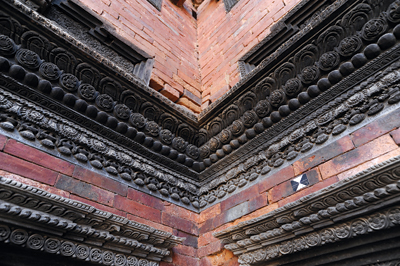
There are 550 engraved wooden Shiva Lingas around the Sundari Chowk palace
According to Ranjitkar, works involving water body architecture is a specialized process involving the restoration of water supply and drainage. He says, “We have almost completed restoring the original supply line but it is a difficult procedure because with newer constructions, much of the pipeline was destroyed. At some places, we had to dig really deep!” About the drainage, he says, “Previously, the hiti water used to be drained out into the square side, but you know that when it rains heavily, the square gets submerged, so we have directed the drainage towards the garden now.” Another point he makes is, “Due to faulty renovation in the past, the drainage was not good and in fact, backflow led to corrosion of the stone figures on the lower alcoves turning them greenish. We have solved this problem by digging up the courtyard flagstones and inserting waterproofing materials to prevent backflow. Of course, all the stones were marked and put back in their original places.”

Restorer Dr. Rohit Ranjitkar of KVPT
No doubt, the work might take some time to be completed, but seeing as to how much of minute details need to be worked out, it is to be expected that haste is not a word that can be found in a restorer’s dictionary. Besides, there are other aspects to be considered as well. For instance, three or four struts that have been used in the making of the Patna Museum in the durbar square on the other side. Well, what about them? “We believe they were part of the Sundari Chowk. We’ll have to try and recover them,” says Ranjitkar.


